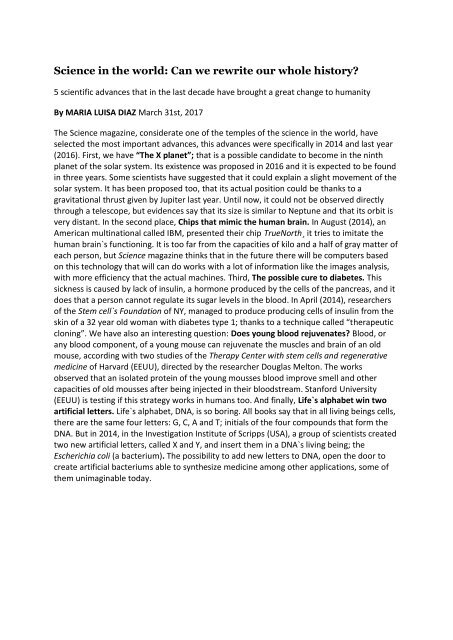Science in the world (malu)
You also want an ePaper? Increase the reach of your titles
YUMPU automatically turns print PDFs into web optimized ePapers that Google loves.
<strong>Science</strong> <strong>in</strong> <strong>the</strong> <strong>world</strong>: Can we rewrite our whole history?<br />
5 scientific advances that <strong>in</strong> <strong>the</strong> last decade have brought a great change to humanity<br />
By MARIA LUISA DIAZ March 31st, 2017<br />
The <strong>Science</strong> magaz<strong>in</strong>e, considerate one of <strong>the</strong> temples of <strong>the</strong> science <strong>in</strong> <strong>the</strong> <strong>world</strong>, have<br />
selected <strong>the</strong> most important advances, this advances were specifically <strong>in</strong> 2014 and last year<br />
(2016). First, we have “The X planet”; that is a possible candidate to become <strong>in</strong> <strong>the</strong> n<strong>in</strong>th<br />
planet of <strong>the</strong> solar system. Its existence was proposed <strong>in</strong> 2016 and it is expected to be found<br />
<strong>in</strong> three years. Some scientists have suggested that it could expla<strong>in</strong> a slight movement of <strong>the</strong><br />
solar system. It has been proposed too, that its actual position could be thanks to a<br />
gravitational thrust given by Jupiter last year. Until now, it could not be observed directly<br />
through a telescope, but evidences say that its size is similar to Neptune and that its orbit is<br />
very distant. In <strong>the</strong> second place, Chips that mimic <strong>the</strong> human bra<strong>in</strong>. In August (2014), an<br />
American mult<strong>in</strong>ational called IBM, presented <strong>the</strong>ir chip TrueNorth¸ it tries to imitate <strong>the</strong><br />
human bra<strong>in</strong>`s function<strong>in</strong>g. It is too far from <strong>the</strong> capacities of kilo and a half of gray matter of<br />
each person, but <strong>Science</strong> magaz<strong>in</strong>e th<strong>in</strong>ks that <strong>in</strong> <strong>the</strong> future <strong>the</strong>re will be computers based<br />
on this technology that will can do works with a lot of <strong>in</strong>formation like <strong>the</strong> images analysis,<br />
with more efficiency that <strong>the</strong> actual mach<strong>in</strong>es. Third, The possible cure to diabetes. This<br />
sickness is caused by lack of <strong>in</strong>sul<strong>in</strong>, a hormone produced by <strong>the</strong> cells of <strong>the</strong> pancreas, and it<br />
does that a person cannot regulate its sugar levels <strong>in</strong> <strong>the</strong> blood. In April (2014), researchers<br />
of <strong>the</strong> Stem cell`s Foundation of NY, managed to produce produc<strong>in</strong>g cells of <strong>in</strong>sul<strong>in</strong> from <strong>the</strong><br />
sk<strong>in</strong> of a 32 year old woman with diabetes type 1; thanks to a technique called “<strong>the</strong>rapeutic<br />
clon<strong>in</strong>g”. We have also an <strong>in</strong>terest<strong>in</strong>g question: Does young blood rejuvenates? Blood, or<br />
any blood component, of a young mouse can rejuvenate <strong>the</strong> muscles and bra<strong>in</strong> of an old<br />
mouse, accord<strong>in</strong>g with two studies of <strong>the</strong> Therapy Center with stem cells and regenerative<br />
medic<strong>in</strong>e of Harvard (EEUU), directed by <strong>the</strong> researcher Douglas Melton. The works<br />
observed that an isolated prote<strong>in</strong> of <strong>the</strong> young mousses blood improve smell and o<strong>the</strong>r<br />
capacities of old mousses after be<strong>in</strong>g <strong>in</strong>jected <strong>in</strong> <strong>the</strong>ir bloodstream. Stanford University<br />
(EEUU) is test<strong>in</strong>g if this strategy works <strong>in</strong> humans too. And f<strong>in</strong>ally, Life`s alphabet w<strong>in</strong> two<br />
artificial letters. Life`s alphabet, DNA, is so bor<strong>in</strong>g. All books say that <strong>in</strong> all liv<strong>in</strong>g be<strong>in</strong>gs cells,<br />
<strong>the</strong>re are <strong>the</strong> same four letters: G, C, A and T; <strong>in</strong>itials of <strong>the</strong> four compounds that form <strong>the</strong><br />
DNA. But <strong>in</strong> 2014, <strong>in</strong> <strong>the</strong> Investigation Institute of Scripps (USA), a group of scientists created<br />
two new artificial letters, called X and Y, and <strong>in</strong>sert <strong>the</strong>m <strong>in</strong> a DNA`s liv<strong>in</strong>g be<strong>in</strong>g; <strong>the</strong><br />
Escherichia coli (a bacterium). The possibility to add new letters to DNA, open <strong>the</strong> door to<br />
create artificial bacteriums able to syn<strong>the</strong>size medic<strong>in</strong>e among o<strong>the</strong>r applications, some of<br />
<strong>the</strong>m unimag<strong>in</strong>able today.
5 th .






